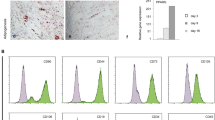Abstract
Purpose
Experimental in vitro models including well-characterised cell lines can be used to identify possible new therapeutic targets for the treatment of osteosarcoma. Culture media including inactivated serum is often recommended for in vitro culture of osteosarcoma cells, but the serum component then represents a nonstandardised parameter including a wide range of unidentified mediators. To improve the standardisation we have investigated whether serum-free culture media can be used in experimental in vitro studies of osteosarcoma cell lines.
Methods
The seven osteosarcoma cell lines Cal72, SJSA-1, Saos-2, SK-ES-1, U2OS, 143.98.2, and KHOS-32IH were cultured in vitro in various serum-free media and media supplemented with 10% heat-inactivated fetal calf serum (FCS).
Results
Although proliferation often was relatively low in serum-free media (X-vivo 10, X-vivo 15, X-vivo 20, Stem Span SFEM), some cell lines (Cal72, KHOS-32IH, Saos-2) showed proliferation comparable with the recommended FCS-containing media even when using serum-free conditions. The optimal serum-free medium then varied between cell lines. We also compared 6 different FCS-containing media (including Stem Span with 10% FCS) and the optimal FCS-containing medium varied between cell lines. However, all cell lines proliferated well in Stem Span with FCS, and this medium was regarded as optimal for four of the lines. FCS could not be replaced by fatty acids or low density lipoprotein when testing the Stem Span medium. The release of a wide range of soluble mediators showed only minor differences when using serum-free and FCS-containing media (including Stem Span with and without FCS), and serum-free Stem Span could also be used for in vitro studies of mitogen-stimulated T cell activation in the presence of accessory osteosarcoma cells. The use of Stem Span with 10% FCS allowed the release of a wide range of chemokines by osteosarcoma cell lines (Cal72, SJSA-1), and the chemokine release profile was very similar to the fibroblast lines Hs27 and HFL1.
Conclusions
Serum-free culture media can be used for in vitro studies of several osteosarcoma cell lines, but the optimal medium varies between cell lines and thus depends on: (i) the cell lines to be investigated/compared; (ii) the functional characteristic that is evaluated (proliferation, cytokine release); and (iii) whether coculture experiments are included.


Similar content being viewed by others
References
Berge RK, Skorve J, Tronstad KJ, Berge K, Gudbrandsen OA, Grav H (2002) Metabolic effects of thia fatty acids. Curr Opin Lipidol 13:295–304
Bruserud Ø, Gjertsen BT (2000) New strategies for the treatment of acute myelogenous leukemia: differentiation induction—present use and future possibilities. Stem Cells 18:157–165
Bruserud Ø, Ulvestad E (2000a) Cytokine responsiveness of mitogen-activated T cells derived from acute leukemia patients with chemotherapy-induced leukopenia. J Interferon Cytokine Res 20:947–954
Bruserud Ø, Ulvestad E (2000b) Acute myelogenous leukemia blasts as accessory cells during in vitro T lymphocyte activation. Cell Immunol 206:36–50
Bruserud Ø, Ulvestad E, Berentsen S, Bergheim J, Nesthus I (1998) T lymphocyte functions in acute leukaemia patients with severe chemotherapy-induced cytopenia: characterisation of clonogenic T cell proliferation. Scand J Immunol 47:54–62
Bruserud Ø, Frostad S, Foss B (1999) In vitro culture of acute myelogenous leukemia blasts: a comparison of four different culture media. J Hematother 8:63–73
Bruserud Ø, Gjertsen BT, von Volkman HL (2000) In vitro culture of human acute myelogenous leukemia (AML) cells in serum-free media: studies of native AML blasts and AML cell lines. J Hematother Stem Cell Res 9:923–932
Bruserud Ø, Glenjen NI, Ryningen A, Ulvestad E (2003) In vitro culture of human acute myelogenous leukemia (ALL) cells in serum-free media: a comparison of native ALL blasts, ALL cell lines and virus-transformed B cell lines. Leukemia Res 27:455–464
Dorfman HD, Czerniak B (1995) Bone cancers. Cancer 75:203–210
Ducy P, Schinke T, Karsenty G (2000) The osteoblast: a sophisticated fibroblast under central surveillance. Science 289:1501–1504
Grav HJ, Tronstad KJ, Gudbrandsen OA, Berge K, Fladmark KE, Martinsen TC, Waldum H, Wergedahl H, Berge RK (2003) Changed energy state and increased mitochondrial beta-oxidation rate in liver of rats associated with lowered proton electrochemical potential and stimulated uncoupling protein 2 (UCP-2) expression: evidence for peroxisome proliferator-activated receptor-alpha independent induction of UCP-2 expression. J Biol Chem 278:30525–30533
Ladanyi M, Gorlick R (2000) Molecular pathology and molecular pharmacology of osteosarcoma. Ped Pathol Mol Med 19:391–413
Ragland BD, Bell WC, Lopez RR, Siegal GP (2002) Cytogenetic and molecular biology of osteosarcoma. Lab Invest 82:365–373
Rochet N, Dubousset J, Mazeau C, Zanghellini E, Farges MF, de Novion HS, Chompret A, Delpech B, Cattan N, Frenay M, Gioanni J (1999) Establishment, characterisation and partial cytokine expression profile of a new human osteosarcoma cell line (Cal72). Int J Cancer 82:282–285
Rochet N, Leroy P, Far DF, Ollier L, Loubat A, Rossi B (2003) CAL72: a human osteosarcoma cell line with unique effects on hematopoietic cells. Eur J Haematol 70:43–52
Sandberg AA, Bridge JA (2003) Updates on the cytogenetics and molecular genetics of bone and soft tissue tumors: osteosarcoma and related tumors. Cancer Genet Cytogen 145:1–30
Spydevold O, Bremer J (1989) Induction of peroxisomal beta-oxidation in 7800 C1 Morris hepatoma cells in steady state by fatty acids and fatty acid analogues. Biochim Biophys Acta 1003:72–79
Tronstad K, Berge K, Flindt E, Kristiansen K, Berge R (2001) Optimization of methods and treatment conditions for studying effects of fatty acids on cell growth. Lipids 36:305–313
Tronstad KJ, Bruserud Ø, Berge K, Berge RK (2002) Antiproliferative effects of a non-beta-oxidizable fatty acid, tetradecylthioacetic acid, in native human acute myelogenous leukemia blast cultures. Leukemia 16:2292–2301
Tronstad KJ, Berge K, Berge RK, Bruserud Ø (2003) Modified fatty acids and their possible therapeutic targets in malignant diseases. Expert Opin Ther Targets 7:663–677
Acknowledgement
The work was supported by the Norwegian Cancer Society and Olaf Ruunshaugens Foundation
Author information
Authors and Affiliations
Corresponding author
Rights and permissions
About this article
Cite this article
Bruserud, Ø., Tronstad, K.J. & Berge, R. In vitro culture of human osteosarcoma cell lines: a comparison of functional characteristics for cell lines cultured in medium without and with fetal calf serum. J Cancer Res Clin Oncol 131, 377–384 (2005). https://doi.org/10.1007/s00432-004-0650-z
Received:
Accepted:
Published:
Issue Date:
DOI: https://doi.org/10.1007/s00432-004-0650-z




